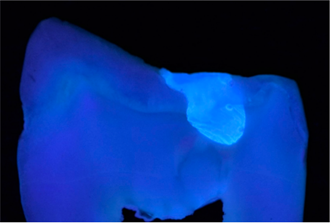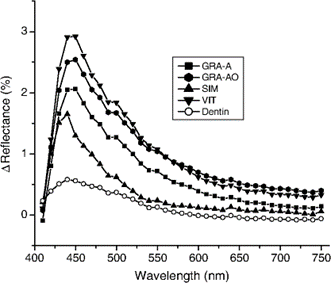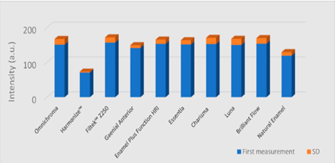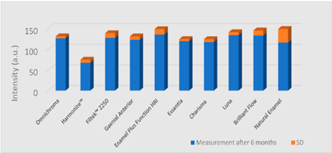Volume 3, Issue 11
November 2023
Fluorescence Light Reflection of Different Dental Materials: A Literature Review
Ahmed Elhejazi, Yazeed A Alzamel, Hisham F Abushaqqaf, Salman S Albalawi, Yazeed A Assiry, Talal Ahmed Alkahlan
DOI: http://dx.doi.org/10.52533/JOHS.2023.31108
Keywords: fluorescence, light, reflection, dental
Fluorescence, the emission of light by a material after absorbing photons, is a property that has been extensively studied and utilized in various fields. In dentistry, fluorescence plays a crucial role in assessing the esthetic outcomes of dental restorations and prostheses. Different dental materials, such as resin composites and ceramics, exhibit distinct fluorescence characteristics. Understanding how these materials interact with fluorescent light is essential for achieving optimal esthetics in dental treatments. Therefore, fluorescence light reflection of different dental materials is a topic of great significance in the field of dentistry. Researchers have employed various methods to investigate the fluorescent light reflection of dental materials. These methods include spectrophotometry, fluorescent microscopy, and digital imaging techniques. By analyzing the fluorescence emission spectra and intensity, valuable insights into the optical properties of different dental materials have been obtained. Studies have shown that factors such as material composition, surface roughness, and color stability can influence the fluorescence light reflection of dental materials. For example, resin composites with certain additives or modifications may exhibit enhanced fluorescence, resulting in more natural-looking restorations. Furthermore, advancements in digital imaging technology have allowed for the development of fluorescence-based devices, such as fluorescence imaging cameras, to aid in clinical assessments. These devices enable dentists to evaluate the esthetic integration of dental materials within the oral environment, leading to improved treatment outcomes. Overall, the investigation of fluorescence light reflection of different dental materials offers valuable insights into their optical properties and their potential impact on esthetics. The understanding gained from this research can aid in the selection and characterization of dental materials, ultimately enhancing the esthetic outcomes of dental treatments.
Introduction
Aesthetic dentistry is one of the most emerging fields of dentistry in terms of the demands of the patients. Since aesthetics play a vital role in physical, psychological, and social well-being in an individual’s life they are critically important. Several research studies have reported that among different populations, about 20.4% to 50% of adults have been dissatisfied with the appearance of their teeth (1, 2). Moreover, well-aligned teeth with brighter teeth is a combination that is desired the most. Keeping this in mind, many different restorative materials have been introduced, along with techniques to improve the visual characteristics of these materials. In general, dissatisfaction with the appearance of the teeth has led to an increased demand for a dental restoration that offers greater aesthetics to the patients.
The goal of dental restorations is to mimic the optical properties of the teeth in order to achieve the desired levels of aesthetics. Recently, new composite resins with fluorescence properties have been introduced. In terms of ideal properties, restorative materials should possess fluorescence properties that are similar to that of natural teeth (3). Fluorescence is a phenomenon whereby a substance absorbs light and within 10 seconds of activation, it emits a larger wavelength. This phenomenon takes place when the surface of the tooth is illuminated with ultraviolet (UV) radiation, some light is absorbed, and some light is emitted that appears as fluorescence. The natural tooth emits a weak bluish-white fluorescence when under ultraviolet light (4). Under different lighting conditions, fluorescence increases the vitality of restoration and reduces the metameric effect between teeth and restorative materials. Restorative materials that do not possess fluorescence properties tend to appear darker under UV light and therefore the tooth appears darker (5) (Figure 1).
When the restoration has been placed, they should match the color of the teeth in both natural and artificial light sources. In the oral cavity, composite undergoes diverse changes, including ageing over time, compromising the physical, chemical, and aesthetic properties (7).

Figure 1: Image of a cross-section premolar slice in UV light (385 nm), revealing the differences in fluorescence between dental tissues and a restoration with Charisma®. The digital equipment used was a DSLR camera (Nikon D3100) equipped with a macro-objective (Tamron 90 mm), ISO 200, f/22, exposure time: 1/200 s (6)
Teeth that possess poor fluorescence properties may appear dull or discolored, which can negatively affect the overall aesthetics of the smile (6). It has been demonstrated that certain CAD/CAM restorations have provided higher fluorescence properties as compared to hard tissues of the tooth (8). Some specimens of composite demonstrated similar fluorescence intensity as compared to the natural tooth structure. Recently, high performance polymers have been introduced in dentistry as they offer superior properties. However, it has been demonstrated that such polymers regardless of their suitable and superior properties have a negative impact as a result of artificial ageing (9). Furthermore, recent evidence of 10 years storage of resin-based composite has suggested that it undergoes ageing as the color shade and fluorescence intensities decrease as time passes on (10) Therefore, materials that undergo ageing at a lesser pace and their fluorescence properties are not altered to a large degree are needed. Dental restorations in the oral cavity are largely subjected to insults by the means of chemical, thermal, and mechanical modalities (11). In recent times as aesthetic dentistry is flourishing fluorescence light reflection of different dental materials is significant domain of study due to its impact on enhancing aesthetic outcomes among patients therefore, we perform an elaborated review of the present literature in this regard.
Methodology
This study is based on a comprehensive literature search conducted on October 27, 2023, in the PubMed, Web of science, Science direct and Cochrane databases, utilizing the medical topic headings (MeSH) and a combination of all available related terms, according to the database. To prevent missing any possible research, a manual search for publications was conducted through Google Scholar, using the reference lists of the previously listed papers as a starting point. We looked for valuable information in papers that discussed the information about the fluorescent light reflection of different dental materials. There were no restrictions on date, language, participant age, or type of publication.
Discussion
Fluorescence of restorative dental materials and its importance
The ultimate esthetic dentistry takes into account the conservation of healthy tooth structures integrated with biologic and long-term functional requirements. Therefore, materials and techniques that address these inseparable issues are necessary for true excellence. Closely matching natural teeth with an artificial restoration can be one of the most challenging procedures in restorative dentistry. It is only possible to duplicate in restorative materials what has been distinguished, understood, and communicated in the shade matching process of the natural dentition. In this aspect, fluorescence, opalescence, and translucency are critical for dental restorative materials to mimic the optical properties and appearance of natural teeth. Ideally, a restorative material should have fluorescence similar to that of natural teeth. Fluorescence needs to be tested in addition to color, as the two characteristics are uncorrelated. In fact, fluorescence is becoming more important due to the widespread use of artificial lighting with blue or UV contributions. Human dentin and three of commercial resin composites investigated showed fluorescence peaks, with a peak wavelength of 440 to 450 nm (Figure 2) (4).

Figure 2: Human dentin and three of commercial resin composites investigated showed fluorescence peaks, with a peak wavelength of 440 to 450 nm (4)
Since the existence and intensity of the restorative materials allow for the achievement of an aesthetic result that is considerably closer to reality, fluorescence is a vital optical feature for aesthetic rehabilitation. Researchers and physicians do not yet completely understand the fluorescence behavior of natural teeth and cosmetic restoration materials. The choice, indication, and therapeutic application of these materials will benefit from a deeper comprehension of this phenomenon. It has a bluish-white tint and is more pronounced in the dentin of normal teeth than in the enamel. The addition of materials containing rare-earth luminescence centers, specifically lanthanide luminescence centers, imparts fluorescence into dental resins and ceramics. This further enables them to realistically mimic natural teeth in appearance. Nonetheless, the dearth of understanding regarding this optical phenomenon among experts suggests the necessity for additional scientific research and education on this subject. Variable spectral compositions and fluorescence intensities of aesthetic materials make them incompatible with real teeth in some cases. Age, temperature, and bleaching are a few variables that might affect the fluorescence of teeth and restorative materials. Studies using various approaches use a variety of instruments for fluorescence evaluation and quantification, but there are not enough of them, making it challenging to compare the findings (3). Improved optical qualities have been built into currently available direct restoration materials to mimic the natural tooth's interaction with light. This study set out to examine the fluorescence of several composites made of enamel resin. Nine enamel composite brands were examined in vitro for this review; several of the brands have been identified by manufacturers as having the capacity to modify color. A fluorescence spectrophotometer was used to measure the fluorescence spectra of the composite specimens and the natural enamel of humans both immediately following preparation and six months later (6).
The lowest fluorescence intensity values were measured in the case of Harmonize™ (Kerr Dental) composite specimens (Table 1). The measured values in this group were significantly lower than the values of the enamel samples group (p = 0.005) and all the other composite groups (p = 0.01). All the other composite groups showed significantly higher values than natural enamel (p = 0.01). Fluorescence intensity data are given in Figure 3 and Figure 4. The reduction of the values after 6 months and statistical significance are shown in Table 1 (6).

Figure 3: Column graph of the fluorescence intensity values (in arbitrary units) from the first measurement, representing the mean and standard deviation (SD) of each type of composite and the enamel (6)

Figure 4: Column graph of the fluorescence intensity values (in arbitrary units) measured after 6 months, representing the mean and standard deviation (SD) of each type of composite and the enamel (6)
|
Table 1: Reduction of the fluorescence intensity values after the second measurement for each material and the enamel specimens; p values are based on Mann–Whitney nonparametric tests (6) |
||
|
p-Value |
Reduction after 6 Months, in Percentage |
Materials |
|
0.01* |
16.0% |
Omnichroma |
|
0.149 |
5.2% |
Harmonize™ |
|
0.01* |
18.66% |
Filtek™ Z250 |
|
0.01* |
13.05% |
Gaenial Anterior |
|
0.01* |
11.39% |
Enamel Plus Function HR |
|
0.006* |
20.91% |
Essentia |
|
0.01* |
22.95% |
Charisma |
|
0.07 |
10.64% |
Luna |
|
0.03* |
13.33% |
Brilliant Flow |
|
0.16 |
2.48% |
Natural Enamel |
|
Table 2. Intensity change after ten years expressed in percent of the initial intensity (mean and standard error of the mean) (10) |
||
|
Brand |
Intensity change [%] |
n |
|
Ceram-X® Duo |
90 (±2) A |
7 |
|
EcuSphere® |
78.4 (±0.6) B |
11 |
|
Empress® Direct |
78 (±2) B,C |
8 |
|
FiltekTM Supreme XT |
78 (±4) B,C |
8 |
|
Esthet-X® HD |
75.9 (±0.7) B,C |
31 |
|
ENAMEL Plus HRi® |
75 (±1) B,C |
13 |
|
Tetric EvoCeram® |
74.8 (±0.6) B,C,D |
14 |
|
Spectrum®TPH3 |
74.7 (±0.6) B,C,D |
6 |
|
Amaris® |
73 (±1) B,C,D,E |
9 |
|
Venus® Diamond |
72.4 (±0.4) B,C,D |
29 |
|
Miris®2 |
72 (±1) B,C,D |
13 |
|
ENAMEL Plus HFO® |
71 (±1) C,D,E |
15 |
|
Venus® |
69 (±2) D,E |
27 |
|
Grandio® |
65.4 (±0.5) E,F |
16 |
|
Charisma® |
60.3 (±0.5) F |
21 |
Groups linked by the same letter do not differ statistically significantly.
Materials included some of the most commonly used brand names for composites employed by dentists worldwide in the past 10 years, A storage of ten years for the tested samples was able to decrease the fluorescence intensity to about 70% (10). Moreover, thermocycling and immersion in each beverage (Black tea and soft drink were considered for this study) had different effects on dental materials. Universal composite, universal nanohybrid composite and universal nano-filled composite, were used as dental materials, the mechanical and tribological properties of nanohybrid composite and nanocomposite were less sensitive to temperature change and to immersion in beverages in comparison with those of the conventional dental composite (11). This study provides an in-depth understanding of fluorescence light reflection properties of various restorative materials and signifies their importance in this regard which are the strengths of our study however due to the dearth of studies in literature more comprehensive findings could not be illustrated which is the limitation of this paper.
Disclosure
Conflict of interest
There is no conflict of interest.
Funding
No funding
Ethical consideration
Non applicable
Data availability
Data that support the findings of this study are embedded within the manuscript.
Author contribution
All authors contributed to conceptualizing, data drafting, collection and final writing of the manuscript.
